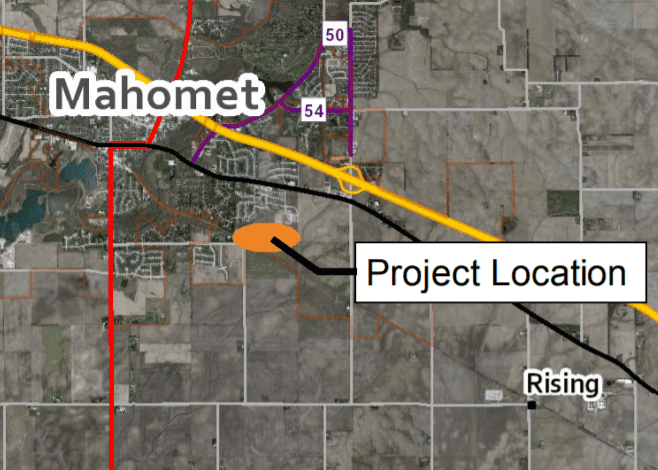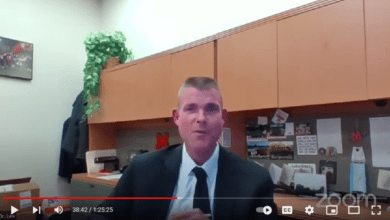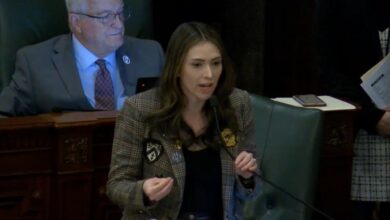Discussion on drainage easement lead to South Mahomet Road

*Editor’s Note: The Mahomet Daily published an article in October recounting the Mahomet-Seymour School Board’s discussion and vote on funds to cover a drainage issue. Through subsequent FOIA requests, a broader picture was painted as to how the district was responsible for that payment. Additional information may be available as we continue to work on this story.
By Taylor Castro
CU Citizen Access
Oftentimes, what happens in a board meeting isn’t the entire story.
The details of any motion made or passed at monthly board meetings are usually ironed out behind the scenes through in-person meetings, emails and phone calls between the parties involved. Sometimes those details come together quickly. Other times, they take years to solidify.
Either way, what the public sees in many cases has already been presented to board members, in one way or another, who are primed to take a vote.
Mahomet-Seymour constituents saw this play out in an October board meeting of the local board of education.
An agenda item on the Oct. 18 meeting packet stated that the school district had an “obligation” to complete on-site underground storm sewer work at the Middletown Prairie campus as private land west of Middletown Prairie Elementary (MPE) developed.
That obligation may have been the first time the public was made aware of the situation, yet, through a Freedom of Information Act (FOIA) request made by CU-CitizenAccess, it is evident that all parties involved, including the boards, were aware of a developing situation as early as 2016 and 2017. It started with a drainage issue and led to an agreement for South Mahomet Road while the school district finalized their plans for Phase II construction on the elementary school.
Although it appears that nothing was finalized in document form, those discussions and agreements led to the board of education approving $26,000 of funds in 2021, three years after the 2018 Phase II was complete: $16,000 for two manholes that developer Darrin Peters will put into the storm drainage system, plus an additional $10,000 for the cost of dredging.
The remaining cost of doing so was covered by Peters of Vertical Towers, LLC. Like the school district, Peters’s property lies within the Conway Farms subdivision, obligating both entities to be part of the Homeowners Association (HOA) or Property Owners Association (POA).
Normally, HOAs take care of costs associated with dredging a drainage pond, but in this case, the silt from construction on the school district site added more sediment than would normally be there.
HOAs and POAs are different because the members of a POA do not have to own the property they represent. These properties are also not always residential. They can be commercial or taxpayer-based. The POA members can make decisions about a certain area.
Because the school district is half of the POA, which was established in 2012, it may affect voting on certain issues. The district representation on the POA board is currently Chief School Business Officer Heather Smith.
Whether or not the Mahomet-Seymour School District needed to send their drainage water into the Conway Farms detention basin or not seems to be up in the air, even after reading emails between Village of Mahomet Community Development Director and Planner Kelly Pfeifer and former Mahomet-Seymour Schools Superintendent Rick Johnston.
The emails show that by the end of Phase I of the elementary school that then housed Pre-K and kindergarten students, a storm pipe on the south side of the school was installed, but was not compliant with the approved construction plans.
Early in 2016, Pfeifer reached out to Johnston stating that the Village needed to be in the loop concerning site development to assure “site development design and execution.”
Illinois law states that drainage from a property cannot be any more or less than what would naturally flow to any area. It also needs to continue in the natural direction it flows.
What the district didn’t know during Phase I, though, is that they could have created a drainage basin of their own as they began to develop the 70-plus acre site that eventually will be home to two Mahomet-Seymour schools.
In emails provided through the FOIA request, little is finalized in terms of the drainage or road issues in the next few months. In April, it appears that Peters meets with school board members Jenny Park and Max McComb.
The idea of South Mahomet Road was not discussed in public until 2018, when the Village told constituents that a railroad crossing on Center Street would need to be closed for the project on the east side of town. Some newly-elected members of the school board became aware of the plan at a 2019 joint meeting with the Village to discuss the future of the district site and Mahomet-Seymour Junior High School.
With South Mahomet Road, Peters has access to develop 15 acres from the north and the south while residents will also have another access point to the district site.
According to the Mahomet Daily, the project was projected to cost $1.8 million in 2019. The Village bonded against $8.5 million in Tax Increment Financing (TIF) funds, and will use $1.17 million in coronavirus relief money to bridge the gap to a now $11 million dollar project, according to the News-Gazette.
Water and sewer work are already underway. The extension from Churchill, across the railroad tracks to the current South Mahomet Road is expected to be completed in 2022. Paperwork for the petition has been filed (Documents for T21-0113) to the ICC and must be approved before South Mahomet Road Phase II, extending the road from Churchill to Prairieview begins in 2023.




